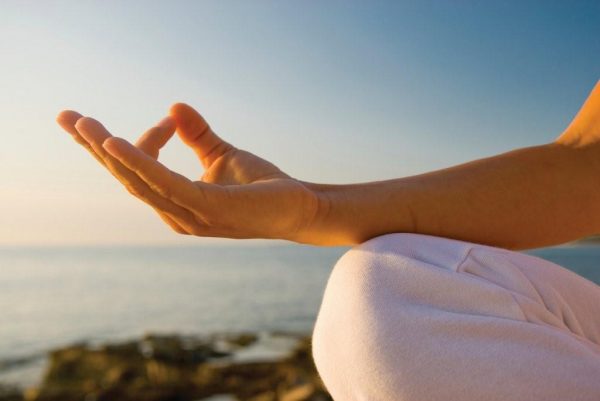Silent? Sitting? Walking? Visualizing? Chanting?
There are many types of meditation – each one engages or focuses your attention in different ways. But which one do you choose?
You’ve probably heard of these: visualization, contemplation, walking, chanting, watching your breath, silent mantra meditation, TM, Relaxation Response, and mindfulness. There are so many brand names, practices from various traditions, and names for practices in a variety of languages. However, there are three elements to all meditations, and that includes mindfulness meditation.
The How & The What & The Why (Your Commitment)
There are three elements to any meditation technique: how you pay attention, and what you pay attention to, and your commitment to practice.
The how is usually gentle focus, a restful, steady attention. It’s not a harsh or militant concentration. And the what is usually something simple – like the sensation of your breath, or a thought or a sound you make or hear.
Quieting the mind, or meditation in general can seem impossible to do especially for a beginner who is just told to sit there and stop thinking. The mind is used to wandering and having one thought after another – they say almost 60,000 thoughts a day. So it makes sense that it might be hard to settle down at first. Especially if you haven’t had instruction.
That’s why people use a specific focus in meditation – that’s the what. The focus is what helps to interrupt the constant flow of thoughts. When thoughts are interrupted, the mind naturally settles down and subtler and subtler levels of thought occur, until it sometimes seems like there’s no thought, but instead, there’s a powerful, nourishing silence. And that feels good. But you can’t think your way to silence. A quiet mind is a natural occurrence that naturally occurs and gets easier with a daily practice of meditation as the attention grows used to turning inward.
Then there is the why. The why is different for everyone. The why also includes your resolve to being and stick with the practice. Here are some examples of why people commit to their practice. They know it can and will:
- Activate the healing response or prevent disease
- Increase your ability to focus and be less distracted
- Relieve insomnia, improve sleep
- Reduce stress, increase feelings of calm, relaxation, and balance
- Help you through a transition, or deal with difficult emotions, or recover after trauma or tragedy
- Reduce the effects of aging
- Help you identify what you really want out of life and clarify goals
- Increase your understanding of your own & others’ emotions & increase compassion
- Create more confidence
- Help you to befriend yourself
- Increase athletic performance
- And so much more!
Some meditations have you focus of sound, others on physical sensations or movement.
It’s often easiest to choose one or two things to focus on. This is called Focused Attention practice. Objects for meditation can include your breathing, an image you visualize in your mind or a real image you look at such as a candle flame or sacred icon. Some focus on physical movement or sensations, while others have you focus on a sound you make or one you hear. Meditation isn’t the same thing as setting goals, or being hypnotized, or giving your personal power away, or going into a trance.
All meditation and mindfulness practices seem to have a common aim: to focus the active mind on an object and to train your attention to be more engaged. Eventually you’ll be able to be more present to yourself, what you think, say, and do, and that which you are engaged in.
Here are some examples of Focused Attention Meditation Practices (FA) and some of the brand names or common names for them:
- Repeating a mantra or word out loud or silently (Transcendental, Relaxation Response, Japa)
- Counting or following the breath (Mindfulness, Insight, Zazen, Vipassana) – see below
- Gazing at a candle flame (Trataka)
- Gazing at a mandala or picture of a spiritual teacher or saint (Contemplation)
- Cultivating Compassion (Tonglen, Metta, Loving Kindness)
- Contemplative prayer (Christian, Judaic, Islamic)
- Becoming aware of the Energy centers (Kriya, Kundalini, Chakra)
- Gratitude meditations
- Mediations on various scenes or scenarios in your mind (Guided, Visualizations)
- Meditation in Motion such as Yoga, Tai Chi, Qi Gong, Walking, Kinhin, Sufi Dancing
There is another type of practice that doesn’t include a particular focus.
These are called Open Awareness Practices (OA) which opens your awareness like a wide angle camera lens and can include present moment awareness and some forms of mindfulness and Vipassana.
There are so many types of practices, and each will give you a unique experience. The most important thing is to find one you like, and just do it. Knowing about meditation will not give you the benefits. Doing it will. Whichever type of meditation you choose, done correctly, your body and mind will soon reach a naturally-occurring relaxed state; and according to research, this state is different from sleep, as the rest is much deeper, and at the same time, you are more alert. It is sometimes called the state of restful alertness.
Mindfulness
Mindfulness is one of the most commonly practiced meditation techniques.
What are you doing right now? You are probably sitting and reading this. But what else are you doing? Thinking? Eating? Listening to music? Spending time with your family? What if you paid attention to one thing at a time, without judgment, and fully brought your attention to it?
You can do it now, bring your attention to the way your body feels in the chair. Feel your feel on the floor. Now, pay attention to the sounds in the room at this moment. Now move your attention to your breath.
Being mindful is just what it sounds like: letting your nonjudgmental awareness be completely engaged with what you are doing, while you are doing it. It sounds simple, and it is, but isn’t always easy. We often get really distracted by our thoughts as we have thousands each and every day. They don’t suddenly stop just because we are meditating! But being mindful is a way of life for many, and is the subject of a lot of research these days.
Any activity done with mindful awareness can also train the brain, and doesn’t require sitting a certain way, or even focusing on the breath.
For instance, you can be mindful of the sensations of your feet while walking, or the feeling of warm soapy water on your hands while doing dishes. It’s simple – your attention is ideally engaged with whatever is happening in the present moment, and instead of getting wrapped up in the mind’s constant commentary, you simply witness it.
And with practice, over time, you will naturally focus most of your attention to the present moment, with what is really happening in your life, whether you are meditating, eating, showering walking, or brushing your teeth. You move from the domain of “doing” to “being” while in action. Your attention moves from the “idea” of your life to the actual experience of your life. And this can be the path to peace and fulfillment.
Is mindfulness the same as meditation?
Mindfulness is a way of life and it can be a formal meditation which also trains your attention, as you continue to bring your awareness back (i.e. from thoughts of the past or the future, or distractions of any kind) into the present moment, back to what is actually happening, to the focus of your meditation. The three formal go-to practices for mindful meditation are walking meditation, breath awareness practice, and body awareness practice.
However, all meditations ideally begins with mindfulness. And the practice of meditation helps you to live you whole life mindfully.
Meditation – Using the Sensation of Touch
Some sensation based meditations ask you to focus on how your whole body ‘feels’ as you sit or move. Some meditations include feeling your body as it moves through space as in a dancing or walking meditation. Others ask you to engage in a gradual body relaxation or scanning, or focus on body pain, tension, warmth or relaxation in different areas. Some practices combine body scanning with breathing exercises: imagining the breath reaching different parts of the body and all of these meditations have a healing effect.
Some sensation based techniques involved feeling or counting the beads of a mala, or rosary or prayer beads. Typically you’d measure one by one with your fingers while repeating a mantra or prayer either silently or out loud while sitting.
There are also those meditations which cultivate a certain feeling or emotion, such as kindness, peacefulness, or compassion. The most common in this category is the Loving Kindness meditation practice where you explore your open heart while cultivating kindness for yourself and others.
The most common: mindful breath awareness.
This is a sensation based practice which involves attending to the subtle sensations of the breath and noticing the movement of the breath as you naturally inhale and exhale.
If you’ve never really meditated, consider starting with Mindful Breath Awareness. It’s practiced in activity, as well as a formal sitting meditation. Paying attention to the breath is a simple way to connect to the present moment, become more self-aware, and more mindful. Your breath is always in the present moment.
The meditation is simple. As you sit and pay attention to the breath, you notice the subtle sensations of inhaling and exhaling. This practice isn’t a breathing exercises, nor does it require you to imagine or control the breath. Instead it is about feeling the sensations of breathing.
When thoughts about the future or past distract you away from the moment and the breath, you are asked to simply return to the focus – without judgement. This practice eventually creates a sensation of witnessing your thoughts, ideas, emotions, and physical sensations rather than being controlled by them.
Read through the following instructions to practice a formal Mindful Breath Awareness meditation.
It’s natural not to remember each and every step, but as time goes by it will become second nature.
If you haven’t already read the Five Essentials of Meditation – It is suggested you do so now.
- Determine how long you’ll be doing this practice before you start. It can be about 5 – 20 minutes.
- Keep track of the time by looking at a clock or watch. Don’t set an alarm that will make you get up to shut it off.
- Sit comfortably. Your eyes can be open, half-closed, or closed. Turn off music, sounds, TV, what have you.
- Remember to let go of expectations, be kind to yourself, complete the entire practice period, and don’t give up.
- Breathe naturally through your nose.
- Bring your awareness to each breath, focusing on the movement and sensations the air creates as it moves in and out of your body.
- As the breath enters and leaves through your nostrils, notice the cool air on the inhale, the warmer air on the exhale.
- Feel your chest and back rise and fall on the inhalation and exhalation.
- Feel your belly expand and contract.
- Allow the breath to come and go in its own natural pattern.
- There’s nothing to figure out, nothing to control, nothing to change.
- There are many little things to notice about the way breath feels, and if you start paying attention to it, eventually you’ll settle into meditation.
- Keep your focus on each breath. Then, for a few breaths, let your attention rest on the natural pause between the exhale and inhale.
- Whenever you notice your attention has drifted away from your breath—shifting to a noise, a thought, or some other distraction—simply refocus your attention to the breath.
- This is a practice, so don’t give yourself a hard time about losing focus. Distractions are natural. Be kind to yourself without concern for how many times you drift off.
- If you get distracted by a physical sensation, recognize it, but don’t attempt to figure out why it’s happening, or go into a story about it. Simply keep the sensation company with your awareness. When it dissipates, gently return your attention to your breath.
- You may find your breathing spontaneously gets faster or slower, deeper or shallower; it may even pause for a moment. Observe any changes without controlling, resisting, anticipating, or expecting anything.
- Don’t judge your experience or worry about how many times your attention drifts away.
- Rest your attention on the breath and its sensations for your predetermined period of time.
- When the period comes to an end, take your attention off your breath.
- Sit or lie still for a few minutes more. This is the Integration Period.
- After a few minutes, slowly open your eyes and take your time moving back into activity.
This breath awareness practice is one of the many practices we teach that can help to train your attention to stay in the present moment. The present moment, the one right now, is where you live your life – it’s where the action is.
Meditation involving Movement:
Moving meditations may be particularly helpful to those who find it hard to sit still and can be spontaneous, free-form movement, or highly structured, choreographed, repetitive patterns. Some methods include:
- Tai chi. Tai chi involves gentle, deliberate circular movements combined with deep breathing. As you concentrate on the motions of your body, you develop a feeling of peace and tranquility.
- Yoga. In the Western world, yoga involves a series of postures, during which you pay special attention to your breathing — exhaling during certain movements and inhaling with others. You can approach yoga as a way to promote physical flexibility, strength and endurance, relaxation, or as a way to enhance your spirituality.
- Qi gong. This technique arises from ancient China. Similar to yoga and tai chi, it integrates physical postures, breathing techniques and focused attention.
- Sufi walking or dancing: This form of moving meditation was developed in medieval Islam, where practitioners walk or dance in a rhythmic fashion while chanting. The intent of the chant is to focus the mind on a specific quality of the divine. You can whirl too for a time, as some whirling dervishes do, and notice how the stillness can be found within activity.
- Walking meditation. Called kinhin in Zen Buddhism, this form of movement meditation focuses the attention on the feeling of the earth beneath the feet. You can use this technique anywhere — in a tranquil forest, on a city sidewalk or even inside a building where you work. You can walk in a circle or a line going back and forth, inside or out of doors. Some people use the practice as they walk a labyrinth.
How to Practice Walking Meditation:
As you walk, you simply attend to your senses: feeling the earth beneath the feet, the movement of your body, the ever-changing balance of the body, the sounds you hear, what you see, etc. This practice can help you become intimate with the body in action – and for some, this creates a more observable focus than a still meditation.
After some practice with Walking Meditation, you’ll learn to use it anytime you are walking. You can use it informally when you go shopping, at work, walking down the street, or walking to or from your car. You can learn to enjoy walking for its own sake – instead of the usual planning and thinking that can distract you. You learn to be where you are, in the present moment, as you move through your life.
Read through the following instructions. Do this meditation for a fixed period of time as you would a sitting meditation, it’s suggested to do this technique for 10-20 minutes. You can do it by itself, or after or before a sitting meditation period.
- Turn off your phone. Do this practice in silence.
- Select a quiet place where you can walk comfortably.
- Begin by standing at one end of this “walking path,” with your feet firmly planted on the ground.
- Let your hands rest easily, wherever they are comfortable.
- Close your eyes for a moment, center yourself, and feel your body standing on the earth.
- Give yourself a deep breath in and out.
- Keep your eyes lowered, gazing toward the ground a few steps ahead.
- While walking, attend to the sensation of your feet, noticing the contact as it touches the ground.
- Notice the pressure on the bottoms of your feet and the other natural sensations of standing.
- If your attention drifts away, notice what else took your attention and then return to the feet.
- Begin to walk slowly with a sense of ease and awareness.
- Pay attention to your body as you go from being still to moving.
- With each step feel the sensations of lifting your foot and leg off of the earth.
- Be aware as you place each foot on the earth.
- Relax and let your walking be easy and natural. Feel each step mindfully as you walk.
- When you come to the end of your path, pause for a moment.
- Center yourself, mindfully turn around, and pause again so that you can be aware of the first step as you walk back.
- You can experiment with the speed, walking at whatever pace keeps you most present.
- Continue to walk for 10-20 minutes or longer.
- As with a sitting meditation, your mind will wander around many, many times. As soon as you notice this, acknowledge it and return to feel the next step. It’s like training a puppy, keep bringing it back.
- Whether your attention was distracted for one second or for ten minutes, simply acknowledge where it was, and come back to being here and now with the next step you take.
- Be kind to yourself.
- When you finish, experience yourself standing. Notice the stillness.
- Bring your attention to what is keeping you upright.
- Feel your body’s weight as it sinks down your legs through the soles of your feet into the earth.
- Simply stand, and experience yourself, and, with a deep breath, bring this walking meditation session to a close.
Optional: Some people like to imagine lotus blossoms springing up after each step. Or silently say to themselves, “I have arrived” in each step. Some prefer to signal the beginning and end of a walking meditation with a ritual, such as the ringing of a bell, a ceremonial bow, a silent prayer, or a gratitude prayer. Discover what works for you.
Meditation – Using the Sense of Sight
In a meditation using a visual focus, sometimes you focus on a physical image “out there” such as a candle flame, or a picture or symbol of someone or something that evokes a sense of the divine. Some people use a yantra (yantras are geometrical diagrams, like mandalas)
Some practices use an image visualized in the mind’s eye such as a bright light or star, a symbol such as a crescent, cross, or symbol of Om, a lotus flower, a saint, your personal deity, etc.
How to Practice Meditative Gazing:
Called Trataka in the yoga tradition, meditative gazing is a simple practice involving alternately gazing at an object or point without blinking, then closing your eyes and visualizing it in your mind’s eye. This practice is commonly performed with a candle flame in a dimmed room. Or at night, you could gaze at the moon or a bright star. Or in the daylight, a flower or tree can be your focus. Choose one point and stick with it for the practice. This practice increases the ability to focus your attention, and to create a sense of deep silence and rest. It is also said to also develop the “third” eye – the seat of intuition or that associated with “psychic” powers.
You can do this silent practice before or after or separately from your regular meditation practice.
- Turn off your phones, television, radio, and computer.
- Safely place a lighted candle 3 – 5 feet in front of you at eye level.
- Sit in a comfortable crossed legged position on the floor or sitting up in a chair, feet on the floor.
- Take off your eyeglasses or contact lenses, and adjust the distance between the candle and yourself so that you can observe a relatively clear image of the candle wick without blur.
- Gaze directly into the flame of the candle for approximately two minutes. Keep your eyes relaxed while fixing the gaze on the wick. Try not to blink.
- Then close your eyes and lightly press the palms of your hands against your eyes.
- You should retain the image of the flame at the brow center. If you don’t see it, don’t be disappointed – you will start seeing it with practice.
- Bring your focus to that image. If the image wanders or disappears, bring it back by simply looking for it with your inner vision (with your eyes closed).
- Keep the palms lightly pressed against the closed eyes for an additional two minutes, four minutes in all.
- Open your eyes slowly and re-start the meditation. Do it as often as you like for a total of 20 minutes.
At the end of your practice, slowly open your eyes. Do not get up right away. Move into activity slowly.
Meditation using the Sense of Sound
Some people say or sing a prayer or a chant, others listen to sounds such as those found in nature such as the wind in the trees, or the waves crashing on the shore, others listen to chants or bells or crystal bowls.
Some listen to subtle sounds in their own body, such as the sound of the breath or the sound of their heartbeat. Others listen to sounds in their mind as they read and reflect on words that inspire them, or sounds they silently repeat as in a mantra or Centering Prayer.
The best known and most widely practiced example of sound-focused meditation is Contemplative prayer. Spoken and written prayers are found in most faith traditions. As you read spiritual, sacred, and inspiring texts silently or aloud, you deeply reflect on the meaning. Listening to sacred music, spoken words or any music you find relaxing or inspiring is also a way to reflect using the sense of sound.
A “mantra” is a sound, word, or phrase that is gently repeated to oneself over and over, either aloud, as a chant, or silently. Mantras used in meditation are found in every culture and religion. The sound is a point on which to focus your mind, and the sounds eventually interrupt the constant flow of thoughts (which we hear internally). Over time, this practice trains the mind to settle down to deeper and deeper levels of thought, until the thinker of the thoughts is experienced, the real you.
Religious mantras include the Lord’s Prayer in the Christian tradition, the holy name of God in Judaism or the Muslim religion, or the “Om Mane Padme Hum” mantra of Tibetan Buddhism. Some meditations include repeating the name of a deity, saint, a quality to enliven in life, or a sacred phrase, while sitting, lying down, or doing just about anything. Examples are, “thy will be done,” or “peace”, or “all is well.”
Some mantra meditations use a Sanskrit syllable, words or phrases which, when repeated, will help to focus the mind. These syllables are sometimes called bija sounds. The most common one is “Om,” or “Hum” which are said to be sounds or energies that have no particular meaning, that reflect the sounds of nature, and have always existed in the universe and can neither be created nor destroyed. Some people create their own mantra. You can learn a silent mantra meditation technique in the Simple, Easy Every Day Meditation Program. Find out more here.
Reflective Meditations
Taking the time to sing, pray, read and reflect on the meaning and purpose of life, or what we really want to include in our lives is always nourishing.
The best known and most widely practiced example of meditation is prayer. Spoken and written prayers are found in most religious traditions. You can pray using your own words or read prayers written by others. Contemplative Prayer is practice used by some as a form of meditation.
Another method of reflection is to focus on gratitude or love. Some practices involve reading poems, spiritual works, or sacred texts silently or aloud and quietly reflect on the meaning that the words bring to mind. Listening to sacred music, spoken words or any music you find relaxing or inspiring is also a way to reflect. It’s recommended to use a reflective practice as an adjunct to a silent meditation period.






